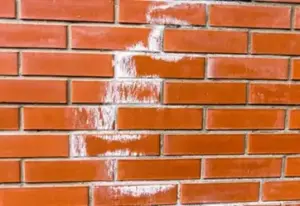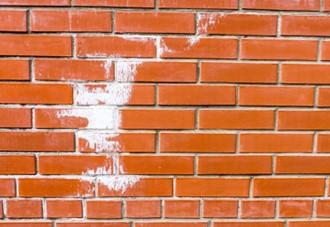What Causes Efflorescence?

Efflorescence, with its distinctive white, powdery appearance, often appears on surfaces such as concrete, bricks, and other porous building materials, leaving homeowners and builders concerned about both the aesthetics and potential damage to the home. This issue is not just cosmetic but a sign of underlying processes involving water and soluble salts. Understanding efflorescence, from its causes to its prevention and removal, is important for maintaining the structural integrity and appearance of any building. In this article, we’ll explain what efflorescence is, what causes it, how to remove it, and how to prevent it.
What Is Efflorescence?
Efflorescence occurs when water seeping through building materials dissolves natural salts and carries them to the surface. Once the water evaporates, it leaves behind a white, crystalline residue that is often mistaken for mold. While it is primarily a cosmetic concern, it can also indicate moisture issues within the structure that may need attention. This condition is most commonly seen in areas with significant moisture exposure, such as basements, exteriors, and within masonry structures.
What are the Causes of Efflorescence?
The occurrence of efflorescence requires a specific set of conditions:
- Presence of Soluble Salts – Building materials and the soil surrounding them often contain natural salts. These salts become soluble when they come into contact with water. The types of salts can vary widely, influencing the color and texture of the efflorescence. Understanding the specific salts involved can help in choosing the most effective removal and prevention methods.
- Water as a Transport Medium – Water is the driving force behind efflorescence. It can originate from various sources, including rainwater penetration, groundwater upwelling, or condensation within the structure. The method of water ingress and the amount of water present play a significant role in the severity and frequency of efflorescence occurrences.
- Material Porosity – The porosity of the construction material is a critical factor in efflorescence. More porous materials provide easier paths for water and dissolved salts to migrate to the surface. Reducing the porosity through the use of specific materials or coatings can significantly mitigate the risk of efflorescence.
- Climatic influences – Environmental conditions have a substantial impact on efflorescence. Areas with high humidity, frequent rain, or dramatic temperature changes are more susceptible. These conditions facilitate the movement of water through materials, bringing dissolved salts to the surface more frequently.
Is Efflorescence A Risk?
Often mistaken for mold, efflorescence is not inherently harmful. However, it can signal potential moisture issues that may lead to structural damage if left unaddressed. It’s important to take proactive measures upon identifying efflorescence on your property to prevent any future complications.
Prevention of Efflorescence
Several strategies can mitigate the risk of efflorescence:
- Applying hydrophobic sealants helps block water absorption and movement within the material.
- Selecting building materials with low salt content and low porosity can dramatically reduce the occurrence of efflorescence.
- Introducing capillary breaks can reduce the risk of salt and ingress.
- Implementing quality masonry techniques including the use of eaves and flashings, can decrease water penetration.
- Thoughtful landscaping and careful placement of sprinklers to prevent water from reaching vulnerable materials can help.
- Employing mechanical vibration during grout installation reduces the possibility of voids in the grout.
- Proper storage of masonry materials off the ground and under waterproof covers protects them from moisture.
- Using grout admixtures enhances the grout mix flow and reduces water content.
Removal Techniques
The optimal approach to efflorescence removal varies with the affected surfaces and the salt composition:
- Simple brushing with a mild detergent followed by rinsing can be effective in removing certain kinds of salts.
- Pressure washing can be effective, but it’s important to dry the surface to prevent a recurrence thoroughly.
- While minor instances of efflorescence can be removed with a vinegar and water solution, stubborn cases may require the use of chemical cleaners that are readily available at home improvement stores.
Addressing Efflorescence Holistically
Efflorescence is more than just an aesthetic issue. It’s a symptom of water and salt movement within porous building materials. By understanding the factors that contribute to its occurrence, property owners and builders can take proactive steps to prevent its appearance. This involves choosing the right materials, implementing effective water management strategies, and applying protective coatings. For existing efflorescence, the combination of removal techniques and preventive measures are keys to ensuring that the problem does not recur. Addressing efflorescence effectively requires a comprehensive approach that considers all contributing factors, from material selection to environmental conditions.
Where to Get Help
Everdry Waterproofing of Wisconsin is your go-to for efflorescence solutions. Leveraging patented technologies, we tackle moisture issues effectively. Our track record since 1989, with over 100,000 satisfied clients, speaks to our commitment to quality and customer satisfaction, backed by a lifetime warranty.
If you would like more information about the products and services we offer, contact us here.
Ready to Get Started?
Contact Us Today to Schedule a No Pressure, No Obligation, Free Quote!

